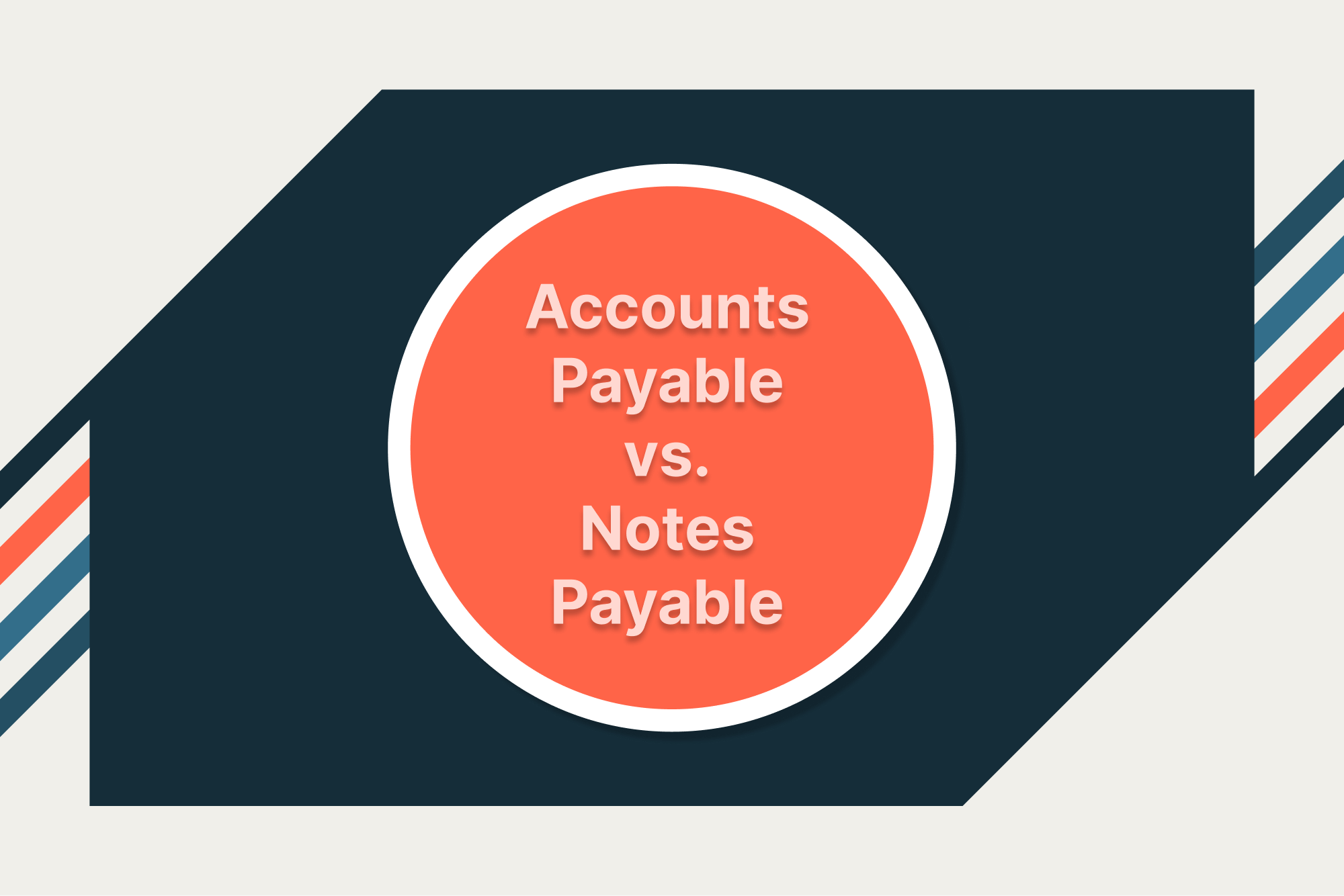In business finance, not all debts are created equal. Know the difference between accounts payable vs. notes payable to optimize your cash flow and fuel growth.
Two key concepts that confuse even financial managers are accounts payable vs. notes payable. But understanding the difference avoids unnecessary costs. So let’s distinguish these two types of liabilities, explain their differences, and give you tips on how to manage them.
What are accounts payable and notes payable?
Both accounts payable and notes payable are obligations — money the company owes.
From there, they start to diverge.
| Accounts Payable | Notes Payable |
| Payable accounts are short-term obligations a company owes its suppliers or vendors for goods. | Payable notes are more formal, documented liabilities that usually involve a written agreement to pay a specific amount of money by a certain date — with interest. |
| Affects short-term working capital, as these liabilities are paid in full within a year. | Impacts long-term cash flow, since payments are spread out over time and include the added expense of the interest payable. |
| Example: Accounts payable is like your electric bill. You use electricity all month, and then the electric company sends you a bill stating what you owe for that period. |
Example: Notes payable is like your car loan. You establish the payment schedule, interest rate, and total amount owed up front. Then you make monthly payments according to those terms. |
Accounts payable.
Payable accounts are short-term obligations a company owes its suppliers or vendors for goods.
Think of it as a credit line extended by the supplier, where payment terms typically range from 30 to 90 days. This line item appears on the company’s accounts payable balance sheet as a current liability because the business is expected to settle the debt within a year.
Efficient accounts payable management maintains a healthy cash flow and good supplier relationships. If you habitually pay invoices late, vendors may refuse to do business with you. On the other hand, when you pay your obligations promptly and in full, you’re more likely to get preferential treatment, like faster order fulfillment and shipping or even discounts.

Notes payable.
Payable notes are more formal. They are documented liabilities that usually involve a written agreement to pay a specific amount of money by a certain date — with interest.
In other words, notes payable are regular payments for loan agreements from credit companies, banks, and other financial institutions.
These can be short-term or long-term obligations, depending on the length of the repayment schedule. Notes payable come with a promissory note, which is a formal written agreement that details the repayment terms, interest rates, and payment schedules.
Still not clear on accounts payable vs. notes payable?
It helps to think of them in more personal terms.
Accounts payable is your electric bill. You use electricity all month, and then the electric company sends you a bill stating what you owe for that period. Notes payable is your car loan. You establish the payment schedule, interest rate, and total amount owed up front. Then you make monthly payments according to those terms.
Your electric bill is a payable account: you use electricity all month, then pay for what you used. Your car loan is a payable note: you pay part of the full sum off on a schedule with interest.

AP Automation Tour
Explore 3-way matching in our AP Automation Product tour.
Key differences between notes payable and accounts payable.
Both are liabilities but they fit into different places in a company’s financial framework and are recorded differently.
Accounting: Treatment and payment terms.
The main difference between notes payable and accounts payable lies in their respective accounting treatment and payment terms. Businesses use a notes payable account to record the amount owed to creditors and track the repayment terms of these formal loans.
Accounts payable are short-term obligations that don’t normally accrue interest — unless they go unpaid. They appear as current liabilities on the balance sheet, which means they need to be settled within a year.
Notes payable typically extend beyond a year and come with formal loan agreements that include both principal and interest payments. They can be short-term or long-term liabilities, depending on the repayment timeline, and they usually include an interest expense, which accounting departments record alongside the principal.
Payment terms: Accounts payable invoices usually have a more flexible timeframe (generally 30-90 days) and may offer discounts for early payments. Notes payable, in contrast, have fixed repayment schedules with penalties for late payments and typically require regular interest payments until the principal amount is paid off, which leads us to . . .
Interest rates and implications.
Accounts payable do not include any interest (unless the vendor adds it to unpaid invoices), which makes them less expensive in the short term. But notes payable usually have either fixed or variable interest rates.
The cost of borrowing money through notes payable quickly adds up and impacts a company’s profitability. That’s why proper notes payable management is critical to maintain cash flow and avoid penalties, particularly for companies that rely heavily on external financing.
| Accounts Payable | Notes Payable | |
| Liability on balance sheet | Yes, short-term. | Yes, usually long-term with the current portion due within 12 months as a short-term liability on balance sheet. |
| Principal plus interest | No | Yes |
| Promissory note | No | Yes |
| Payment terms | Yes | Yes |
| Requires supplier onboarding | Yes | No |
| Purchase order processing | Often | No |
| Invoice processing | Yes | No |
| Part of working capital management | Yes | No |
| Potentially large staff requirements | Yes | No |
Managing accounts payable and notes payable.
It takes effective management of both notes payable and accounts payable to achieve good financial health. Poor management of either leads to:
- Cash flow problems.
- Damage to creditworthiness.
- Higher costs due to late fees or interest expenses.
So let’s look at management techniques for accounts payable vs. notes payable.
Accounts payable management.
To manage accounts payable well, form strong relationships with suppliers and make all payments according to the agreed terms. Many companies automate their accounts payable processes to increase efficiency and reduce the risk of human error.
Accounts payable automation tools integrate with ERP systems to minimize errors and optimize payments, helping you:
- Streamline invoice capture.
- Reduce manual data entry.
- Track payment deadlines.
- Reduce the risk of invoice fraud.
- Take advantage of early payment discounts.
- Avoid late payment fees.
Keeping accounts payable under control is a critical aspect of short-term financial management, but any inefficiencies in this area, like poor bookkeeping or late payments, may lead to long-term challenges down the road.
Notes payable management.
When it comes to notes payable, pay careful attention to the repayment terms of the loan and make regular, ongoing payments to avoid penalties. Any lapse in repayment will lead to additional fees or even collateral loss.
Make sure that all notes payable are accurately recorded on the balance sheet, as they are a major indicator of a company’s financial position. Prioritize repaying notes with the highest interest rates first to minimize overall interest expenses and free up cash for other investments or operational needs.
Practical examples and applications.
Accounts payable and notes payable serve different purposes within a business, so let’s look at some real-life examples.
Retail.
A retail store will use accounts payable to manage its short-term debts to suppliers for inventory purchases. But that same store might take out a note payable to finance a storefront renovation or expansion into a new location.
Agency.
For a marketing agency, accounts payable likely includes invoices from contractors, advertising fees, software subscriptions, and office supplies. If the agency borrows money to hire more employees and expand its services, the loan falls under notes payable.
When you understand when to use each liability and how to manage them effectively, it becomes much easier to maintain a healthy balance sheet and avoid costly financial mistakes like overdue payments and tax miscalculations.

The benefits of automating accounts payable and notes payable processes.
Automation is one of the best ways to streamline both accounts payable and notes payable management. Automated accounts payable software includes tools, processes, and safeguards that:
- Reduce the risk of human error and fraud.
- Improve efficiency and accuracy.
- Help companies avoid missed payments and unnecessary fees.
For accounts payable, automation takes advantage of early payment discounts and frees up working capital by extending payment terms when necessary.
Solutions like Airbase also have automated approval workflows built into the platform. Every invoice received automatically goes to the right department or manager for approval, making it easier to control costs, prevent fraud, and ensure every dollar spent goes toward business growth and development.
Automate all your payables with Airbase.
If you want to keep your business financially healthy, it’s important to understand the differences between accounts payable and notes payable. Each requires unique management, treatment, and record-keeping. Once you get a handle on it, you’ll improve your cash flow, reduce unnecessary costs, maintain positive relationships with suppliers and creditors, and position yourself for long-term success.
But manual management gets complex fast, and that’s where Airbase comes in.
Airbase delivers powerful accounting automation that streamlines the entire accounts payable process, from purchase order and invoice processing to final payment and recording. With Airbase, you get clear insight into money owed, due dates, cash balance, long- and short-term liabilities, and more, so you can make smarter financial decisions for your business operations.
Schedule a demo today and see what Airbase can do for your financial health!
FAQ.
How do accounts payable and notes payable differ on a company’s balance sheet?
Accounts payable entries is the money a business owes a supplier or vendor for products or services. They’re typically short-term liabilities the company will pay off in under a year.
Notes payable entries are regular payments to banks or other financial institutions for a loan the business has taken out. They can be either short or long-term, depending on the repayment terms, but most are long-term and include interest that the company must pay in addition to the principal balance.
What are the key differences in payment terms?
Accounts payable usually have shorter payment terms (30-90 days), with payment expected in full, while notes payable include longer, fixed repayment schedules according to the terms laid out in the promissory note.
Do notes payable involve interest payments?
Yes, notes payable payments often include interest, unlike accounts payable, which do not.
How do these affect a company’s cash flow?
Accounts payable affect short-term working capital, as these liabilities are paid in full within a year. But notes payable impact long-term cash flow, since payments are spread out over time and include the added expense of the interest payable.
How can companies manage these effectively?
Automation enables better management of both accounts payable and notes payable. With a platform like Airbase, you eliminate the manual data entry, recording, and reconciling that makes payable management such a hassle.
 Jira Integration – Streamline Your Workflows
Jira Integration – Streamline Your Workflows  Ironclad Integration – Simplify Legal Operations
Ironclad Integration – Simplify Legal Operations  Asana
Asana 




